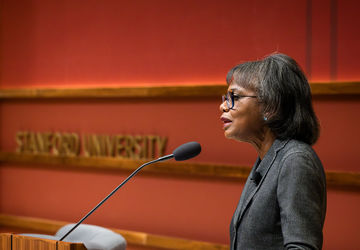The diverse and precarious world of the “influencer economy”

Influencers – people who become famous through social media – are everywhere. But who exactly are these influencers? What characterizes their experiences on social media platforms? And how do these experiences impact the kind of content they produce? These are the questions at the heart of the forthcoming book by Angèle Christin, which she presented in a recent faculty research fellows talk. Christin is an associate professor of communication, and, by courtesy, of sociology, as well as Richard E. Guggenhime Faculty Scholar and faculty director of the Digital Civil Society Lab. Since 2019, she has used a wide range of methods to investigate digital influencers and the broader social worlds in which they operate: she has conducted over one hundred interviews with influencers, assistants, marketers, and agents; she took part in a virtual internship with an influencer agency; she quantitatively analyzed influencer income rates; and she even began producing influencer content herself.
Part of her work is to take influencers seriously as a social phenomenon. Open up an average news article about digital media influencers and the coverage is likely to be condescending and misogynistic. Most often, articles focus on young, white, female influencers, depicting them as vapid and their accounts as vanity projects. Their audiences receive the same treatment: the media frequently treats viewers as young girls who develop unhealthy relationships to online celebrities because of a lack of impulse control. When the news does focus on male creators, the media tends to highlight “bad actors” like cyberbullies and trolls.
In reality, Christin showed in her talk, there are millions of influencers, comprising all genders, races, ages, and topics – and they are at the center of a booming economy. Thousands of businesses now support the “influencer economy”: management companies, training academies, and merchandise producers, just to name a few. In fact, according to Christin, influencers increasingly drive the entire advertising infrastructure of the internet. Those banner ads you see at the top of every web page? They don’t actually work. What does work is influencer endorsements of products and services – and brands are taking notice.
Despite influencers becoming a collective economic juggernaut, Christin has found that individual content creators still have uneasy relationships to money. Most people don’t start out with the goal of becoming rich and famous. Instead, they find some kind of community online and make content to participate within that community. Over time, those who find enough success start making money, and some become successful enough that it can be their full-time job. Even so, they feel constant anxiety about revenue streams and their ability to have longevity on social media platforms. Influencers also fear that platform algorithms could automatically remove their income at any time, with no avenues for recourse.
According to Christin, the economic pressures faced by influencers shape the kind of content they make. Some influencers rely on brand partnerships, which means their income relies on their ability to effectively sell the products and services of the brands they work with. This leads to a lot of pressure to make content that is “safe” for advertisers – which often comes with gendered and racial connotations of what counts as “safe.” (Content promoting social movements like Black Lives Matter? Not “brand safe.”) And white male influencers, on the whole, make more money through their brand partnerships than women and people of color.
Some influencers avoid these complications by getting most of their income through merchandise and crowdfunding from their fans. These influencers emphasize their independence from brands, even portraying other influencers as fake. But, Christin showed, these influencers face another problem. Their fans can demand a kind of purity that leads them to adopt more and more extreme positions. For example, one vegan influencer named Freelee the Banana Girl promoted a diet that consisted entirely of fruit. This extremism can reinforce rigid gender and racial norms (Freelee promoted her diet as a route to achieving traditional feminine beauty ideals).
Overall, Christin’s work shows that influencers navigate a host of structural pressures. Social media is not just a space filled with vapid women and trolling men. Influencers of all kinds are responding to new economic structures and the gender and racial dynamics that come with them.


